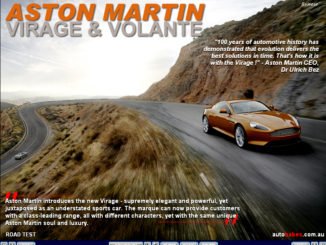![Aston-Martin-V12-Zagato_3-800[1]](https://autobabes.com.au/wp-content/uploads/2011/05/Aston-Martin-V12-Zagato_3-8001-678x381.jpg)
– Pics and Words by Wouter Melissen
Aston Martin V12 Zagato !In 1960 Aston Martin called in the services of Italian coach-builder Zagato to raise the on-track performance of the DB4 GT model to Ferrari 250 GT levels. At the time, the Milan-based company was one of the foremost experts in lightweight and efficient bodies, which more often than not gave models from the likes of Abarth, Alfa Romeo and Lancia the edge over the competition. The resulting DB4 GT Zagato was first shown to the public at the London Motor Show late in 1960 and made its on-track debut at Goodwood in 1961. Unfortunately the Zagato bodied Aston Martin failed to match the Ferraris in international GT racing and only 19 were completed. It has nevertheless become one of the most sought after Aston Martins ever Celebrating the legendary model’s fiftieth anniversary, the two fabled companies have collaborated once again in 2011. This has resulted in the V12 Zagato launched during that year’s Concorso d’Eleganza Villa d’Este. Like its illustrious predecessor, the latest Zagato Aston Martin is built as a Grand Tourer with an eye on the racing track. In fact, the prototype is scheduled to take part in the Nürburgring 24 Hours in June. Whereas the Italian coach-builder took the lead in previous collaborations, Zagato’s role in this project has been limited to assisting with the styling executed by Aston Martin’s design team led by Marek Reichman. This is clearly reflected in the end-result, which still includes many of Zagato’s familiar cues but overall is a departure from the company’s recent designs. A mix of Aston Martin and Zagato DNA, the final design is both elegant and brutal. The front-end is the latest interpretation of the current Aston Martin style, while the subtle ‘double-bubble’ roof and exposed circular tail lights have Zagato written all over them. Among the car’s most dramatic features are the deep cut-outs in the front wings. The body is hand-crafted in aluminium at Aston Martin’s Gaydon factory, using traditional methods like the English wheel. This is a very labour intensive method but with pre-formed panels, the intricate shapes of the V12 Zagato’s design just could not be recreated. The front wings alone, for example, consist of seven different pieces of aluminium. Once completed, the body is mounted on a V12 Vantage chassis. This compact platform features a 510 bhp V12 engine and will also form the basis for Aston Martin’s 2012 GT2 racer. The chassis itself is a spaceframe constructed from bonded aluminium sections. Suspension is by double wishbones with adjustable dampers all-round and a semi-automatic six speed gearbox is used to transfer the power to the rear wheels. Sporting the all-revealing serial number, ‘AMLVTWELVEZAGX001’, the V12 Zagato on display at Villa d’Este was built to full racing specifications and is scheduled to make its racing debut this coming weekend. Before the car will take to the track, it will be fitted with additional aerodynamic aids including a rear wing. Although a waiting final confirmation, Aston Martin’s plan is to build a total of 19 V12 Zagatos. Customers will be able to order the car in either road or racing trim. ________________________________________________
________________________________________________ |
________________ ________________ ________________ ________________ |
||||||||||||||||||||||||||||||||||||||||||









Be the first to comment